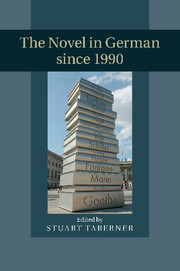Book contents
- Frontmatter
- Contents
- Contributors
- Acknowledgements
- Introduction: The novel in German since 1990
- Chapter 1 Robert Schindel???s Geb??rtig (Born-Where)
- Chapter 2 G??nter Grass???s Ein weites Feld (Too Far Afield)
- Chapter 3 Thomas Brussig???s Helden wie wir (Heroes Like Us)
- Chapter 4 Christa Wolf???s Medea. Stimmen (Medea. A Modern Retelling)
- Chapter 5 Zafer ??enocak???s Gef??hrliche Verwandtschaft (Perilous Kinship)
- Chapter 6 Monika Maron???s Endmor??nen (End Moraines)
- Chapter 7 Martin Walser???s Ein springender Brunnen (A Gushing Fountain)
- Chapter 8 Michael Kleeberg???s Ein Garten im Norden (A Garden in the North)
- Chapter 9 Christian Kracht???s Faserland (Frayed-Land)
- Chapter 10 Elfriede Jelinek???s Gier (Greed)
- Chapter 11 Karen Duve???s Dies ist kein Liebeslied (This Is Not a Love-Song)
- Chapter 12 Herta M??ller???s Herztier (The Land of Green Plums)
- Chapter 13 W. G. Sebald???s Austerlitz
- Chapter 14 Walter Kempowski???s Alles umsonst (All for Nothing)
- Chapter 15 F. C. Delius???s Mein Jahr als M??rder (My Year as a Murderer)
- Chapter 16 Yad?? Kara???s Selam Berlin
- Chapter 17 Daniel Kehlmann???s Die Vermessung der Welt (Measuring the World)
- Chapter 18 G??nter Grass???s Beim H??uten der Zwiebel (Peeling the Onion)
- Select bibliography
- Index
- References
Chapter 17 - Daniel Kehlmann???s Die Vermessung der Welt (Measuring the World)
Published online by Cambridge University Press: 07 September 2011
- Frontmatter
- Contents
- Contributors
- Acknowledgements
- Introduction: The novel in German since 1990
- Chapter 1 Robert Schindel???s Geb??rtig (Born-Where)
- Chapter 2 G??nter Grass???s Ein weites Feld (Too Far Afield)
- Chapter 3 Thomas Brussig???s Helden wie wir (Heroes Like Us)
- Chapter 4 Christa Wolf???s Medea. Stimmen (Medea. A Modern Retelling)
- Chapter 5 Zafer ??enocak???s Gef??hrliche Verwandtschaft (Perilous Kinship)
- Chapter 6 Monika Maron???s Endmor??nen (End Moraines)
- Chapter 7 Martin Walser???s Ein springender Brunnen (A Gushing Fountain)
- Chapter 8 Michael Kleeberg???s Ein Garten im Norden (A Garden in the North)
- Chapter 9 Christian Kracht???s Faserland (Frayed-Land)
- Chapter 10 Elfriede Jelinek???s Gier (Greed)
- Chapter 11 Karen Duve???s Dies ist kein Liebeslied (This Is Not a Love-Song)
- Chapter 12 Herta M??ller???s Herztier (The Land of Green Plums)
- Chapter 13 W. G. Sebald???s Austerlitz
- Chapter 14 Walter Kempowski???s Alles umsonst (All for Nothing)
- Chapter 15 F. C. Delius???s Mein Jahr als M??rder (My Year as a Murderer)
- Chapter 16 Yad?? Kara???s Selam Berlin
- Chapter 17 Daniel Kehlmann???s Die Vermessung der Welt (Measuring the World)
- Chapter 18 G??nter Grass???s Beim H??uten der Zwiebel (Peeling the Onion)
- Select bibliography
- Index
- References
Summary
Non-Euclidean geometry, number theory, and the eighteenth-century geological cult of Neptunism – these and other scientific obscurities scarcely seem to be the stuff of a novel destined to be a global hit. Yet Daniel Kehlmann’s Die Vermessung der Welt (Measuring the World) was precisely that. Following its release in 2005, it topped the German bestseller lists for over a year, sold more than a million copies by 2007, was translated into forty languages, and won a range of literary prizes, including the Candide Prize (2005), the Heimito-von-Doderer Prize (2006), and the Kleist Prize (2006). A book about two German historical figures, the explorer and naturalist Alexander von Humboldt (1769–1859) and the mathematician Johann Carl Friedrich Gauß (1777–1855), opening with their meeting in September 1828 at the seventh German Scientific Congress and then moving back in time to tell, in alternating chapters, of Humboldt’s travels to South America and central Asia and Gauß’s obsession with parallel lines and ‘curved space’, had seemingly demolished the truism that when it comes to German literature and international markets ‘only Nazis sell’. (The previous honourable exception was Patrick Süskind’s Parfum [Perfume] from 1985.) As Mark M. Anderson pithily commented in The Nation: ‘Even more surprising: It has nothing to do with Hitler.’
Frequent references in newspaper reviews to Thomas Pynchon’s Mason & Dixon (1997) and to Latin American magical realists such as Luis Borges, Alejo Carpentier, Gabriel García Márquez and Juan Rolfo confirm both the novel’s global reputation and the intertextual ambition of its author. Without doubt, Kehlmann’s narrative is strongly reminiscent of Pynchon’s tale of the dour Charles Mason (in Die Vermessung, Humboldt is the killjoy), the licentious Jeremiah Dixon (Gauß in the German book), and their desire to give geometric expression to the Age of Reason by mapping the ‘new’ continent of America. The two surveyors of British North America even get a brief, most likely ironic, mention in the text.As far as magical realism is concerned, bizarre happenings or illogical breaks frequently cut across an otherwise matter-of-fact narrative, disrupting the neat categorisations of Enlightenment thinking and revealing the German characters’ inability to cope with phenomena that they cannot measure or explain scientifically. Suddenly confronted by a sea monster off the coast of Tenerife, for example, Humboldt’s reaction points not only to the absence of a capacity for wonder but perhaps also to the rationalist prejudices of German and European culture at the time: ‘He decided to write nothing about it’ (45).
- Type
- Chapter
- Information
- The Novel in German since 1990 , pp. 255 - 269Publisher: Cambridge University PressPrint publication year: 2011



